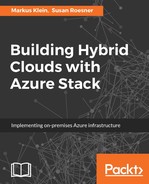HNVv2 makes sure that there are correct layer 2 switching and layer 3 routing semantics to work as a physical switch. A VM that is connected to a HVN tries to establish a connection with another VM in the same subnet by learning its CA MAC. If the ARP of this VM is not on the table, it will send an ARP broadcast to the destination VM's IP to be returned.
The Hyper-V switch will send it to the host agent that will take a look at its database for the corresponding MAC address for the requested destination VM's IP address. If it is available, the host agent will modify the ARP response and send it back to the requesting VM. After the VM has collected all the required layer 2 header information, it sends the frame to the corresponding Hyper-V Port on V-Switch. The switch then tests this frame with the corresponding matching rules of the V-Port and applies different transformations to the frame based on these rules.
If a VM is connected to an HNV virtual network and wants to create a connection to a VM in a different virtual subnet, HNV assumes a star topology with the logic of only one IP address in the CA space to the next hop to reach all IP prefixes (the default gateway). As of today, this is a limitation to the technology as non-default routes are currently not supported.
